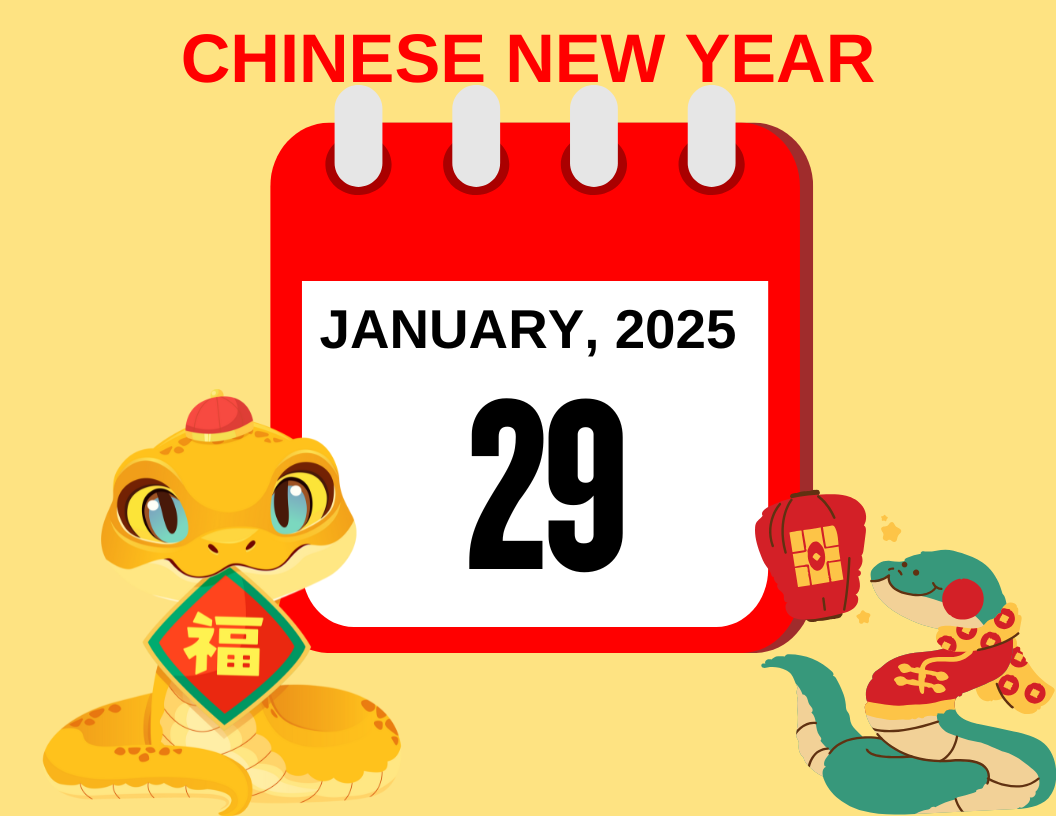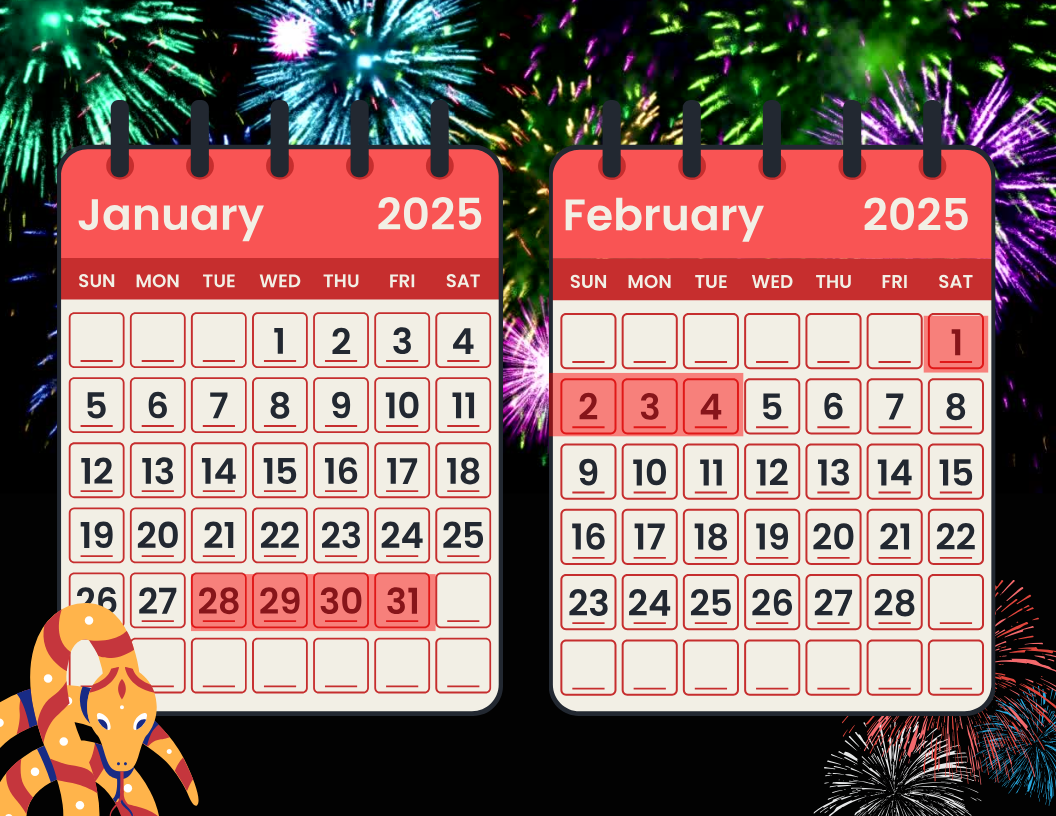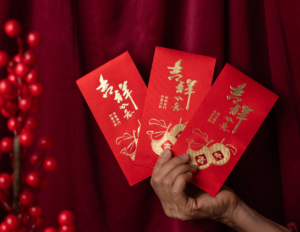
 Chinese New Year, also known as the Spring Festival, is one of the most significant holidays in China and across the Chinese-speaking world. Each year, the festival’s dates vary according to the lunar calendar, making it a moving target for many people planning festivities. In 2025, the Chinese New Year will fall on January 29th, ushering in the Year of the Snake.
Chinese New Year, also known as the Spring Festival, is one of the most significant holidays in China and across the Chinese-speaking world. Each year, the festival’s dates vary according to the lunar calendar, making it a moving target for many people planning festivities. In 2025, the Chinese New Year will fall on January 29th, ushering in the Year of the Snake.
Let’s explore the details of this holiday, including the dates, customs, and some fun facts about this iconic celebration.
When is Chinese New Year 2025?
2025 Lunar New Year falls on January 29th.
The public holiday lasts from January 28th to February 3rd or 4th, during which the New Year’s Eve on January 28th and the New Year’s Day on January 29th are the peak time of celebration, giving Chinese workers a full week off to celebrate. This period is typically when the majority of the celebrations take place, with family reunions, feasts, and fireworks.

Chinese Zodiac: Year of the Snake
2025 will mark the Year of the Snake, the sixth sign of the Chinese zodiac, following the Year of the Dragon in 2024. People born in 2025 will be considered Snake in the zodiac, symbolizing traits like wisdom, charm, and intuition. According to Chinese astrology, Snakes are often seen as calm, calculated, and mysterious.
Each Chinese zodiac sign is associated with specific characteristics, and the Year of the Snake is believed to bring a focus on refinement, introspection, and spiritual growth.
The Duration of Chinese New Year
The official public holiday for Chinese New Year lasts seven days—from the eve of the Lunar New Year to the sixth day of the first lunar month. However, in many regions, the celebrations extend longer, often until the Lantern Festival, which occurs on the 15th day of the lunar calendar.
Many businesses, institutions, and individuals observe a 10-day or longer holiday, especially in major cities like Beijing, Shanghai, and Guangzhou. The extended holiday provides ample time for family gatherings, traveling home to ancestral villages, and taking part in public celebrations.
Chinese New Year Traditions
Chinese New Year is a time filled with rich traditions. These include:
- Reunion Dinners: The most important meal of the year, typically enjoyed on the eve of Chinese New Year. Families gather for a lavish feast that often includes dumplings, fish, and sweet rice cakes.
- Red Envelopes (Hongbao): During the holiday, it’s customary for elders to give children red envelopes containing money. The red color symbolizes good luck and prosperity.
- Fireworks and Firecrackers: These are set off to scare away evil spirits and bring good luck for the coming year.
- Lion and Dragon Dances: Colorful performances featuring dancing lions and dragons are a staple in many public festivities. These dances are believed to bring good fortune and drive away bad luck.
What are the most popular way to say Happy Chinese New Years?
✨ 恭喜发财 (Gōngxǐ fācái) – Wishing you prosperity
✨ 新年快乐 (Xīnnián kuàilè) – Happy New Year
✨ 身体健康 (Shēntǐ jiànkāng) – Wishing you good health
✨ 招财进宝 (Zhāo cái jìn bǎo) – May wealth flow to you
✨ 过年好 (guò nián hǎo) – Have a happy New Year!
What are the most popular dishes for Chinese New Year Dinner?
The significance of these traditional Chinese New Year foods lies in their names or appearances. It’s not just about what’s on the plate but how it’s prepared, served, and savored.
- Fish (鱼 Yú — an Increase in Prosperity
- Chinese Dumplings(饺子 Jiǎoz) — Wealth
- Whole Chicken Chicken is a homophone for ji (吉)- meaning ‘good luck’ and ‘prosperity’).
- Chinese New Year Cake((年糕 Niángāo ) — a Higher Income or Position
- Spring Rolls (春卷 Chūnjuǎn) — Wealth
- Sweet Rice Balls 团团圆圆 (Tuántuán yuányuán) — Family Union
- Longevity Noodles (长寿面 Chángshòu Miàn ) — Happiness and Longevity
- Lion’s Head Meatballs (狮子头, shīzitóu) which are pork meatballs— ‘Family Unity’
- Steamed Pork Belly with Taro — ‘Prosperity’
- Shrimp — ‘Happiness’Vegetables — ‘Spring’, ‘Wealth’
- Fruit — Fullness and Wealth
Chinese New Year 2025: Why the Dates Change
Unlike Western holidays, Chinese New Year doesn’t fall on a fixed date. Instead, it is based on the lunar calendar, which tracks the cycles of the moon rather than the solar year. As a result, Chinese New Year can fall anywhere between January 21st and February 20th.
The lunar year lasts approximately 354 days, which is shorter than the Gregorian calendar, meaning that each year, the dates of the lunar new year shift slightly.
Public Holiday in 2025: A Week of Celebration
While the public holiday lasts for a full seven days, the entire festival period is much longer. In traditional Chinese culture, people begin preparations even earlier, starting on the 23rd day of the 12th lunar month. This marks the beginning of a 15-day celebration that lasts until the Lantern Festival on February 12, 2025.
Many businesses in China shut down during this time, and workers return to their hometowns to reunite with their families. Transport systems are often extremely busy, with millions of people traveling across the country, leading to the world’s largest annual human migration.
What to Expect During Chinese New Year 2025
As the Year of the Snake rolls in, expect a focus on quiet reflection, personal growth, and introspection. The energy of the Snake is considered smooth and intelligent, making this a good time for planning and self-discovery.
- Festivals and Parades: Major cities across China and in Chinatowns worldwide host vibrant parades, featuring dragon dances, acrobats, and musicians.
- Public Celebrations: In addition to parades, street markets selling traditional New Year items, food stalls, and local performances make Chinese New Year a truly communal event.
- Traveling to Home town: As part of the tradition, many Chinese people travel to their home town to be with their family, leading to a massive surge in domestic travel.
Chinese New Year 2025: A Time for Family, Fortune, and Festivities
Chinese New Year 2025 is a time to embrace family, tradition, and the hope for good fortune. Whether you’re attending a parade, hosting a family dinner, or simply enjoying the colorful celebrations, the Year of the Snake promises to bring a year of wisdom, charm, and introspection.
The rich traditions of Chinese New Year, combined with modern-day festivities, make this an unforgettable experience for anyone celebrating.
Chinese New Year Calendar (1930 – 2030)
| Year | New Year Dates | Animal Sign |
|---|---|---|
| 1930 | Jan. 30, 1930 (Thursday) | 🐴 Horse |
| 1931 | Feb. 17, 1931 (Tuesday) | 🐑 Sheep |
| 1932 | Feb. 6, 1932 (Saturday) | 🐒 Monkey |
| 1933 | Jan. 26, 1933 (Thursday) | 🐔 Rooster |
| 1934 | Feb. 14, 1934 (Wednesday) | 🐕 Dog |
| 1935 | Feb. 4, 1935 (Monday) | 🐖 Pig |
| 1936 | Jan. 24, 1936 (Friday) | 🐀 Rat |
| 1937 | Feb. 11, 1937 (Thursday) | 🐂 Ox |
| 1938 | Jan. 31, 1938 (Monday) | 🐅 Tiger |
| 1939 | Feb. 19, 1939 (Sunday) | 🐇 Rabbit |
| 1940 | Feb. 8, 1940 (Thursday) | 🐉 Dragon |
| 1941 | Jan. 27, 1941 (Monday) | 🐍 Snake |
| 1942 | Feb. 15, 1942 (Sunday) | 🐴 Horse |
| 1943 | Feb. 4, 1943 (Friday) | 🐑 Sheep |
| 1944 | Jan. 25, 1944 (Tuesday) | 🐒 Monkey |
| 1945 | Feb. 13, 1945 (Tuesday) | 🐔 Rooster |
| 1946 | Feb. 1, 1946 (Saturday) | 🐕 Dog |
| 1947 | Jan. 22, 1947 (Wednesday) | 🐖 Pig |
| 1948 | Feb. 10, 1948 (Tuesday) | 🐀 Rat |
| 1949 | Jan. 29, 1949 (Saturday) | 🐂 Ox |
| 1950 | Feb. 17, 1950 (Friday) | 🐅 Tiger |
| 1951 | Feb. 6, 1951 (Tuesday) | 🐇 Rabbit |
| 1952 | Jan. 27, 1952 (Sunday) | 🐉 Dragon |
| 1953 | Feb. 14, 1953 (Saturday) | 🐍 Snake |
| 1954 | Feb. 3, 1954 (Wednesday) | 🐴 Horse |
| 1955 | Jan. 24, 1955 (Monday) | 🐑 Sheep |
| 1956 | Feb. 12, 1956 (Sunday) | 🐒 Monkey |
| 1957 | Jan. 31, 1957 (Thursday) | 🐔 Rooster |
| 1958 | Feb. 18, 1958 (Tuesday) | 🐕 Dog |
| 1959 | Feb. 8, 1959 (Sunday) | 🐖 Pig |
| 1960 | Jan. 28, 1960 (Thursday) | 🐀 Rat |
| 1961 | Feb. 15, 1961 (Wednesday) | 🐂 Ox |
| 1962 | Feb. 5, 1962 (Monday) | 🐅 Tiger |
| 1963 | Jan. 25, 1963 (Friday) | 🐇 Rabbit |
| 1964 | Feb. 13, 1964 (Thursday) | 🐉 Dragon |
| 1965 | Feb. 2, 1965 (Tuesday) | 🐍 Snake |
| 1966 | Jan. 21, 1966 (Friday) | 🐴 Horse |
| 1967 | Feb. 9, 1967 (Thursday) | 🐑 Sheep |
| 1968 | Jan. 30, 1968 (Tuesday) | 🐒 Monkey |
| 1969 | Feb. 17, 1969 (Monday) | 🐔 Rooster |
| 1970 | Feb. 6, 1970 (Friday) | 🐕 Dog |
| 1971 | Jan. 27, 1971 (Wednesday) | 🐖 Pig |
| 1972 | Feb. 15, 1972 (Tuesday) | 🐀 Rat |
| 1973 | Feb. 3, 1973 (Saturday) | 🐂 Ox |
| 1974 | Jan. 23, 1974 (Wednesday) | 🐅 Tiger |
| 1975 | Feb. 11, 1975 (Tuesday) | 🐇 Rabbit |
| 1976 | Jan. 31, 1976 (Saturday) | 🐉 Dragon |
| 1977 | Feb. 18, 1977 (Friday) | 🐍 Snake |
| 1978 | Feb. 7, 1978 (Tuesday) | 🐴 Horse |
| 1979 | Jan. 28, 1979 (Sunday) | 🐑 Sheep |
| 1980 | Feb. 16, 1980 (Saturday) | 🐒 Monkey |
| 1981 | Feb. 5, 1981 (Thursday) | 🐔 Rooster |
| 1982 | Jan. 25, 1982 (Monday) | 🐕 Dog |
| 1983 | Feb. 13, 1983 (Sunday) | 🐖 Pig |
| 1984 | Feb. 2, 1984 (Wednesday) | 🐀 Rat |
| 1985 | Feb. 20, 1985 (Sunday) | 🐂 Ox |
| 1986 | Feb. 9, 1986 (Sunday) | 🐅 Tiger |
| 1987 | Jan. 29, 1987 (Thursday) | 🐇 Rabbit |
| 1988 | Feb. 17, 1988 (Wednesday) | 🐉 Dragon |
| 1989 | Feb. 6, 1989 (Monday) | 🐍 Snake |
| 1990 | Jan. 27, 1990 (Friday) | 🐴 Horse |
| 1991 | Feb. 15, 1991 (Friday) | 🐑 Sheep |
| 1992 | Feb. 4, 1992 (Tuesday) | 🐒 Monkey |
| 1993 | Jan. 23, 1993 (Saturday) | 🐔 Rooster |
| 1994 | Feb. 10, 1994 (Thursday) | 🐕 Dog |
| 1995 | Jan. 31, 1995 (Tuesday) | 🐖 Pig |
| 1996 | Feb. 19, 1996 (Monday) | 🐀 Rat |
| 1997 | Feb. 7, 1997 (Friday) | 🐂 Ox |
| 1998 | Jan. 28, 1998 (Wednesday) | 🐅 Tiger |
| 1999 | Feb. 16, 1999 (Tuesday) | 🐇 Rabbit |
| 2000 | Feb. 5, 2000 (Friday) | 🐉 Dragon |
| 2001 | Jan. 24, 2001 (Wednesday) | 🐍 Snake |
| 2002 | Feb. 12, 2002 (Tuesday) | 🐴 Horse |
| 2003 | Feb. 1, 2003 (Friday) | 🐑 Sheep |
| 2004 | Jan. 22, 2004 (Thursday) | 🐒 Monkey |
| 2005 | Feb. 9, 2005 (Wednesday) | 🐔 Rooster |
| 2006 | Jan. 29, 2006 (Sunday) | 🐕 Dog |
| 2007 | Feb. 18, 2007 (Sunday) | 🐖 Pig |
| 2008 | Feb. 7, 2008 (Thursday) | 🐀 Rat |
| 2009 | Jan. 26, 2009 (Monday) | 🐂 Ox |
| 2010 | Feb. 14, 2010 (Sunday) | 🐅 Tiger |
| 2011 | Feb. 3, 2011 (Thursday) | 🐇 Rabbit |
| 2012 | Jan. 23, 2012 (Monday) | 🐉 Dragon |
| 2013 | Feb. 10, 2013 (Sunday) | 🐍 Snake |
| 2014 | Jan. 31, 2014 (Friday) | 🐴 Horse |
| 2015 | Feb. 19, 2015 (Thursday) | 🐑 Sheep |
| 2016 | Feb. 8, 2016 (Monday) | 🐒 Monkey |
| 2017 | Jan. 28, 2017 (Friday) | 🐔 Rooster |
| 2018 | Feb. 16, 2018 (Friday) | 🐕 Dog |
| 2019 | Feb. 5, 2019 (Tuesday) | 🐖 Pig |
| 2020 | Jan. 25, 2020 (Saturday |










